A legend
reborn
A technological marvel and status symbol, the Synclavier dwarfed literally every other synthesizer of the 1980s, in both power and price. Its unique approach to sound design is just as relevant today as it was all those decades ago.
The go-to inspiration station for Sting, Frank Zappa, Kate Bush, Michael Jackson, Chick Corea, and many others began life as an FM synth. It evolved into the first tapeless music production system long before DAWs, adding features like high-res sampling and resynthesis. Nothing got close to this Rolls-Royce of synthesizers, and with maxed-out systems fetching mid six figures, almost no one got close either. Co-created with original inventor Cameron Jones, Synclavier V changes all that.
Your Secret Weapon
No other instrument sounds like the Synclavier, even today. Synclavier V is a source of sounds and ideas as unique as your music.
Beyond the Original
We multiplied the sound-generation capabilities of the original three times over, building a hot-rod that was impossible in hardware.
Exclusive Club
Original Synclaviers are still in use even today because the pros love their sound. Join their ranks without the cost or headaches.
Sonic Chameleon
Combining additive, digital, and FM synthesis with unique sampling features, Synclavier V can truly produce any sound you may have in your mind’s ear.
An experiment
gone right
Born of a college team-up between musicians and engineers, the Synclavier started as a lab experiment and then became the most coveted synth in the music industry.
At prestigious Dartmouth College in the ’70s, students Cameron Jones and Sydney Alonso signed on to a research project with professors Jon Appleton (music) and Frederick Hooven (engineering). The goal: Make a computer behave like a musical instrument.
The prototype Dartmouth Digital Synthesizer became the Synclavier I. This used the FM technique pioneered by Dr. John Chowning of Stanford University, which would see widespread commercial success in the Yamaha® DX7.
Discover the history of Synclavier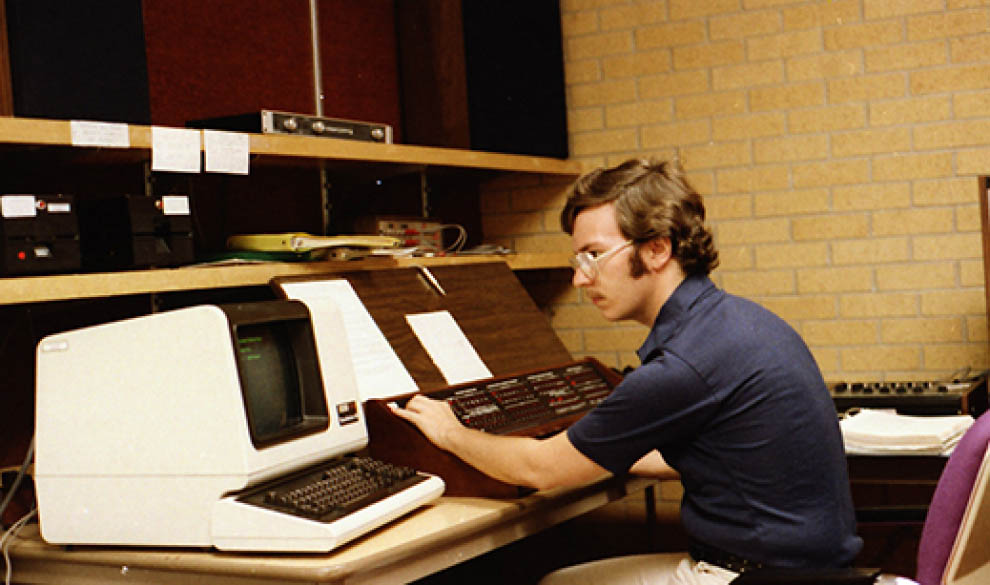
Your Starship Bridge
Awaits
With all this control, it has never been easier or more immediate to perform the sonic miracles the Synclavier made possible.
Users loved the Synclavier’s interface, which involved a bevy of buttons to select parameters and one knob to rule them all. We say lots of knobs are better than one, making the experience even more intuitive.
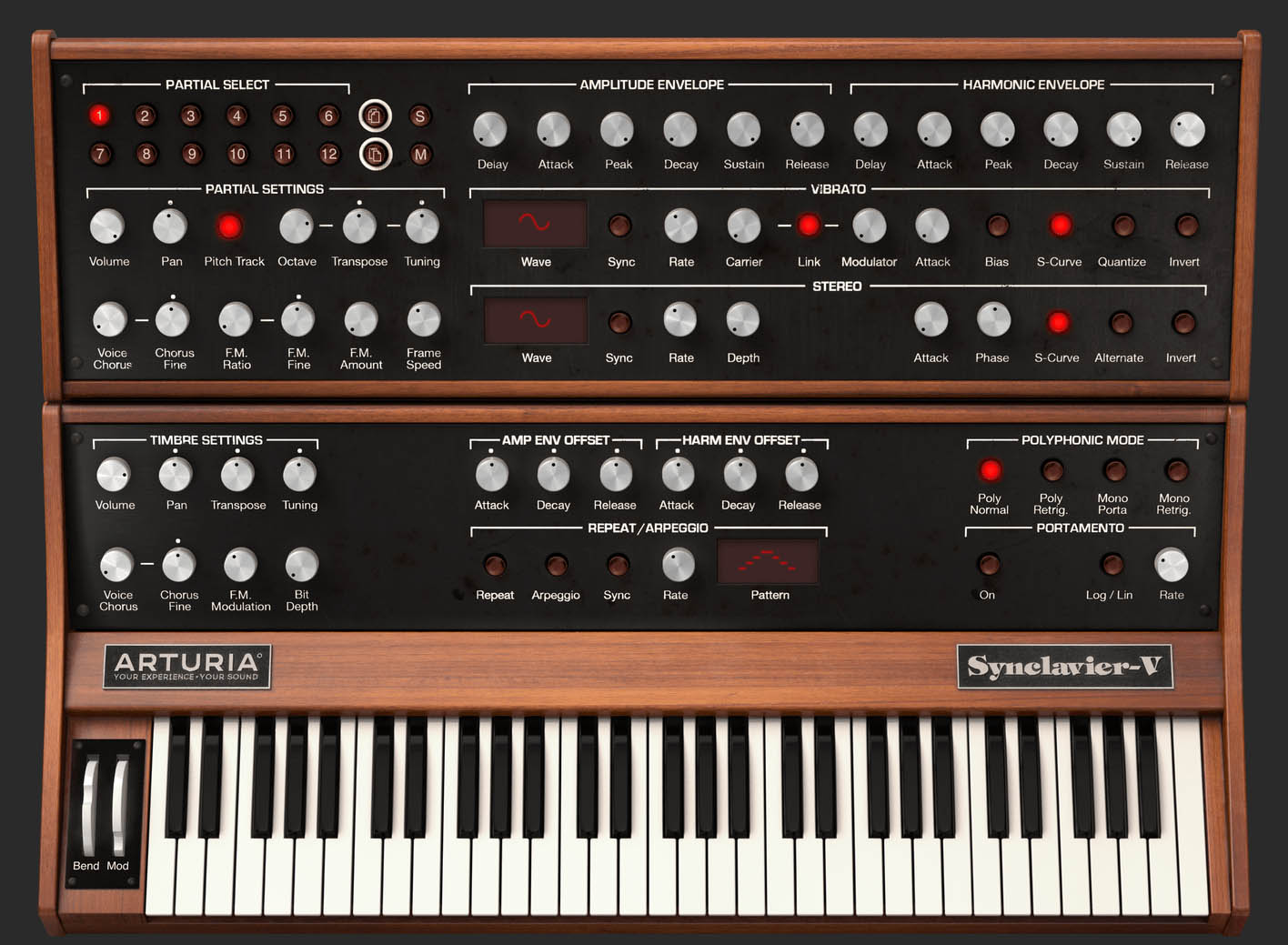
_1
_2
_3
_4
_5
_6
01. Synthesis Without Limits
A single Preset can have up to 12 Partials. Each is a complete additive and FM synthesis chain.
02. Compelling Counterpoints
Every partial has its own volume and harmonic envelope. Timbres can weave around and through each other for ear-engaging sounds.
03. Sonic Surgery
Control every aspect of each partial here, including FM parameters and time-slice behavior. There is no more precise way to build sounds from the ground up.
04. Paint in Broad Strokes
Control settings that affect all Partials in common here, such as pan, transpose, and overall envelope offsets.
05. Space Station
Synclavier V provides very sophisticated control over a stand-alone vibrato and your sound’s movement in the stereo picture.
06. Get Animated
Bring your patches to life with our signature multi-pattern, tempo-syncable arpeggiator as well as polyphonic portamento.
Fantastic
Voyage
A computer screen option allowed precise editing on the original. Synclavier V injects you even deeper into the heart of the sound.
We kept the “green screen” look of the old-school VT100 terminal, then organized everything to enhance and empower your creative flow. Packed with functionality but intuitive, our advanced interface turns you into a sound design expert in record time.
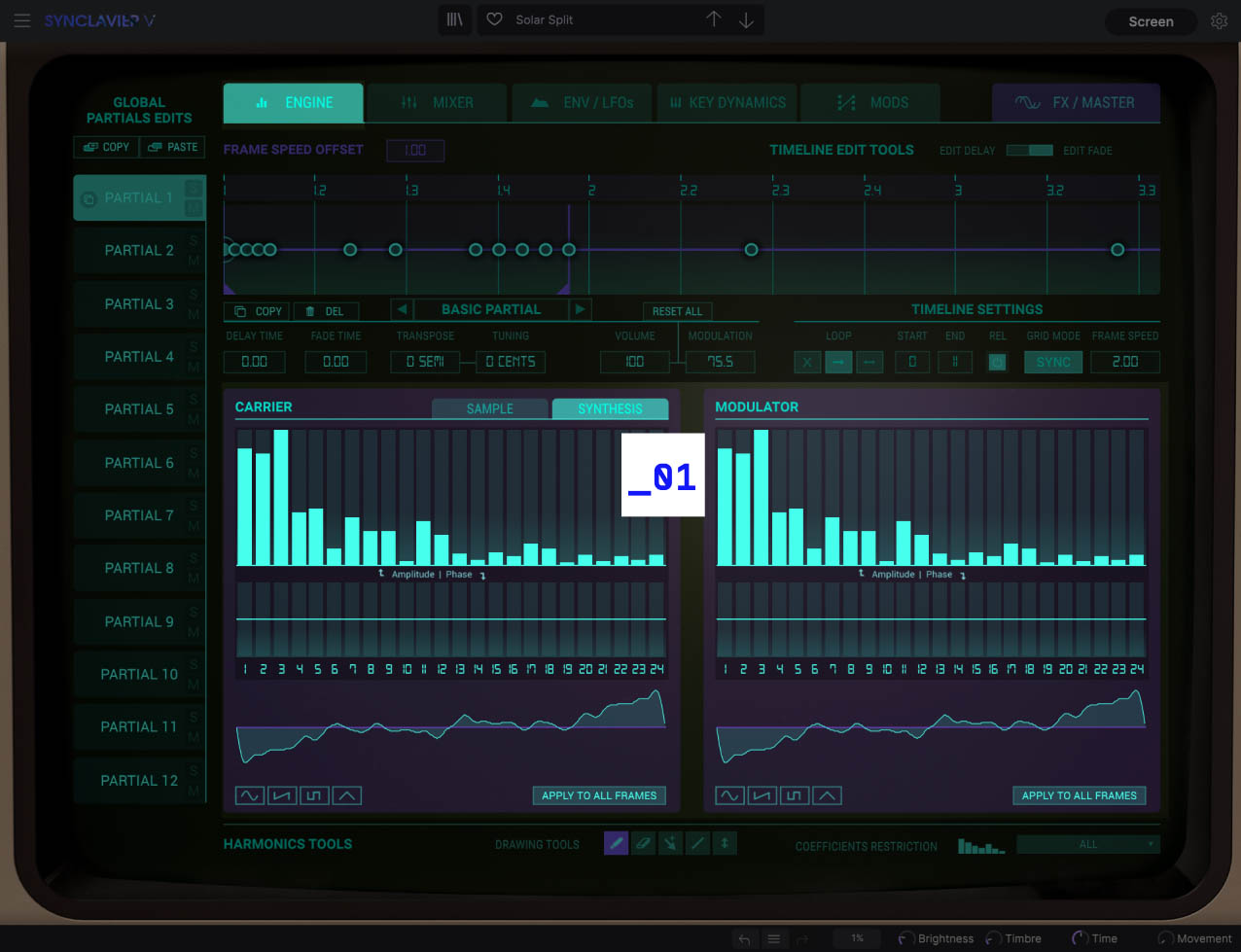
Each Partial lets you use or design any waveform you want for both the carrier and modulator of the FM pair. Then, stack up as many as 12 of them!
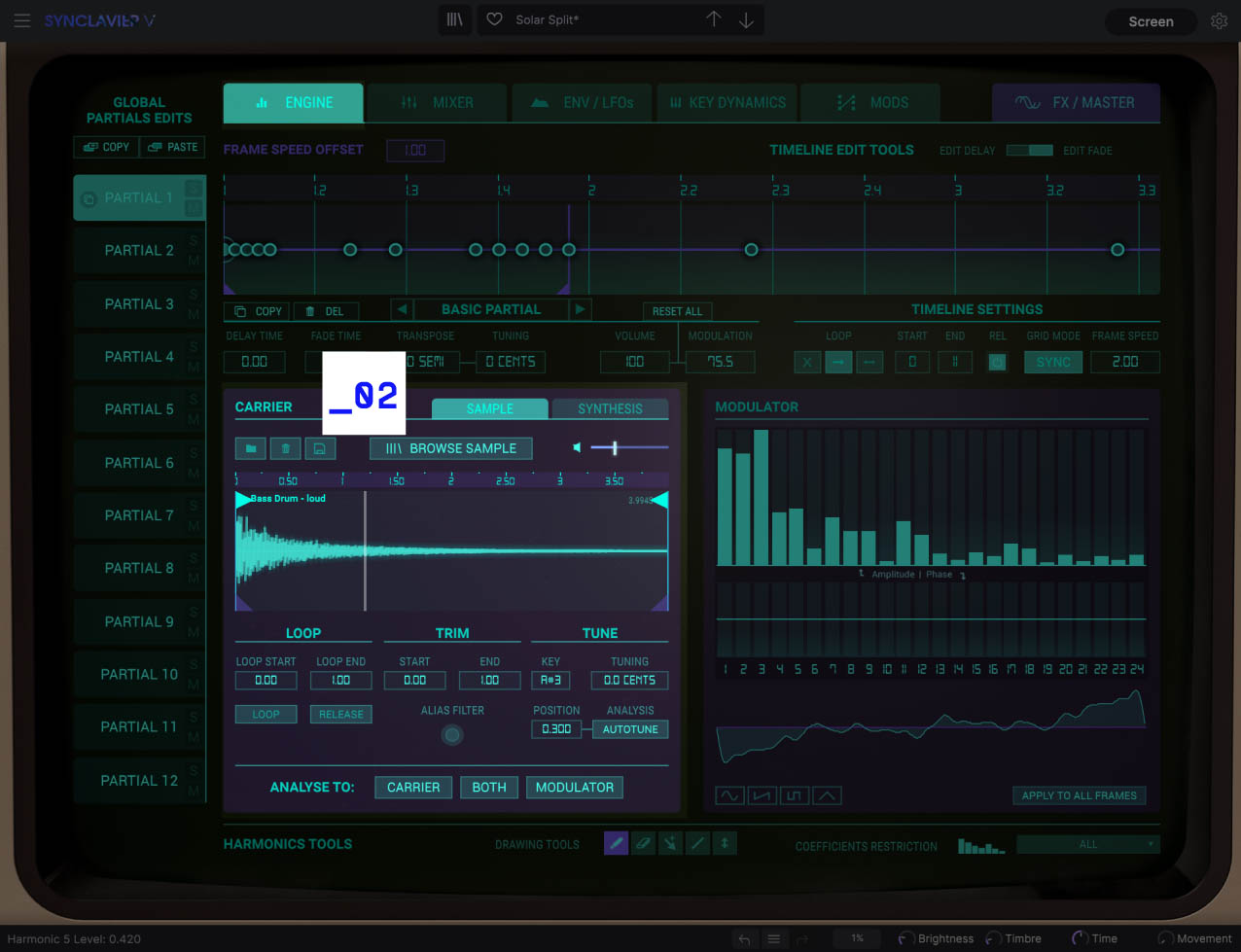
Bring in samples as your sonic foundation, or re-synthesize them as the carrier, modulator, or both.
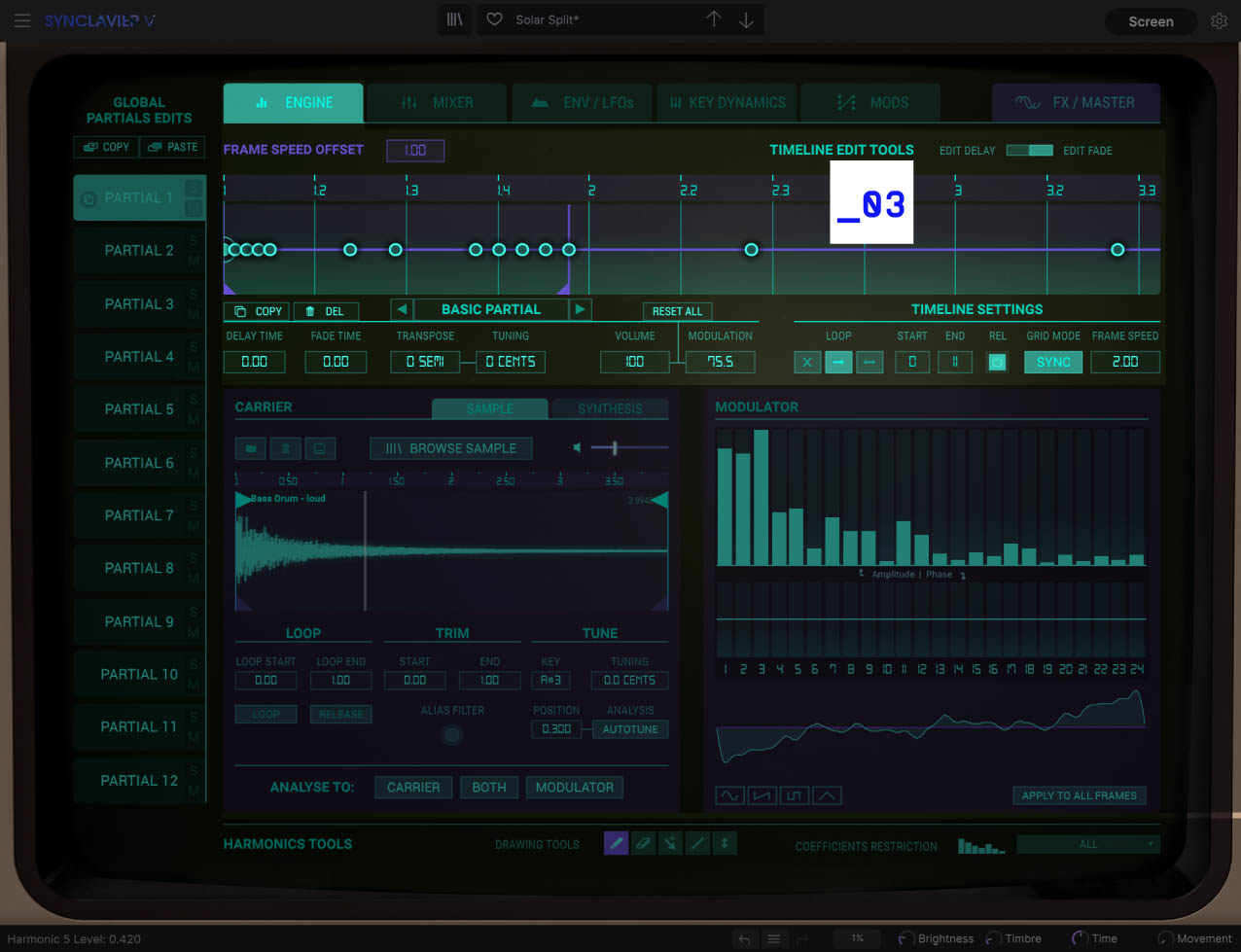
The same Partial can sound totally different at up to 50 snapshots in time. The progression syncs to tempo for sounds that move.
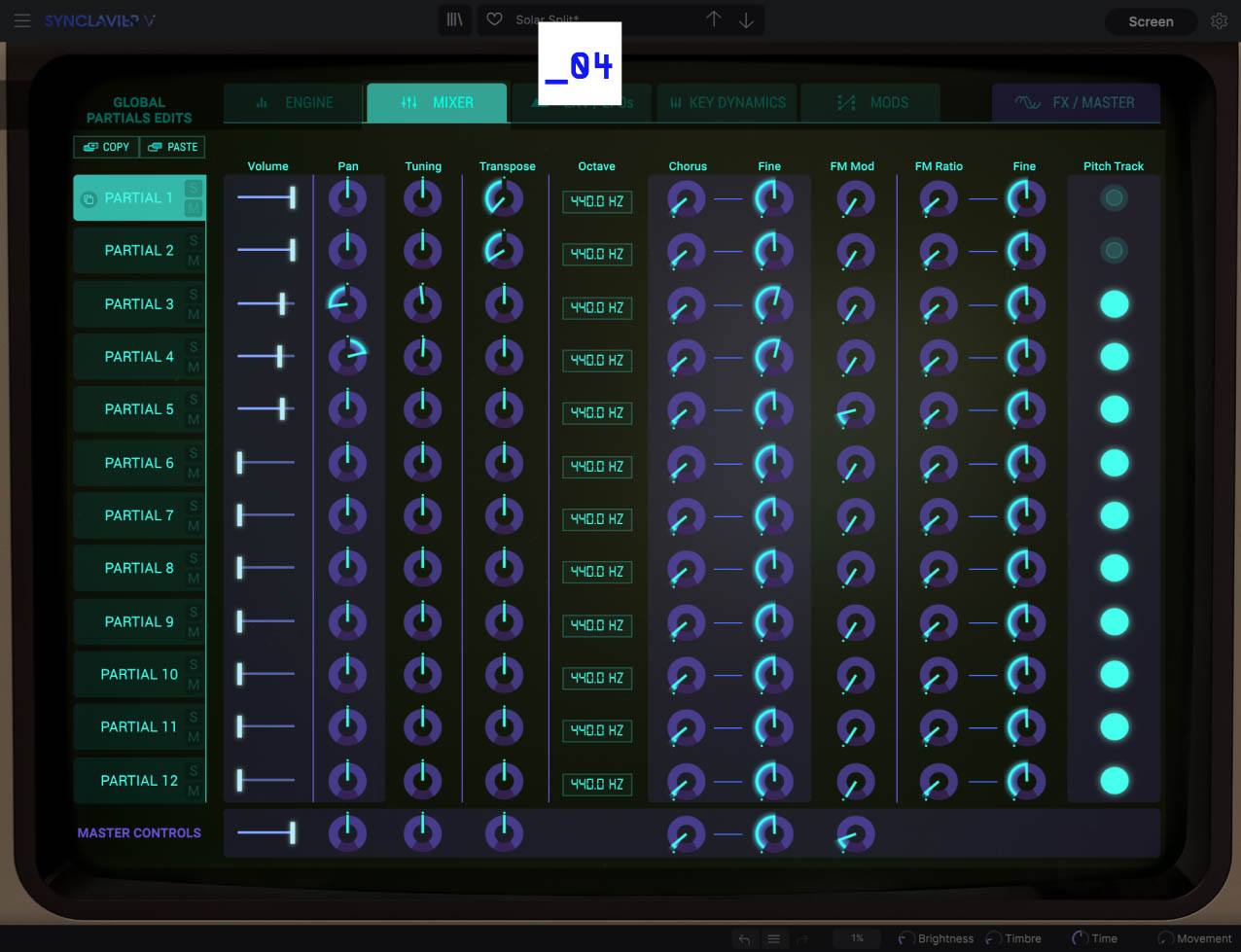
Mix, pan, tune, and transpose all the Partials in one place using the convenient Mixer tab.
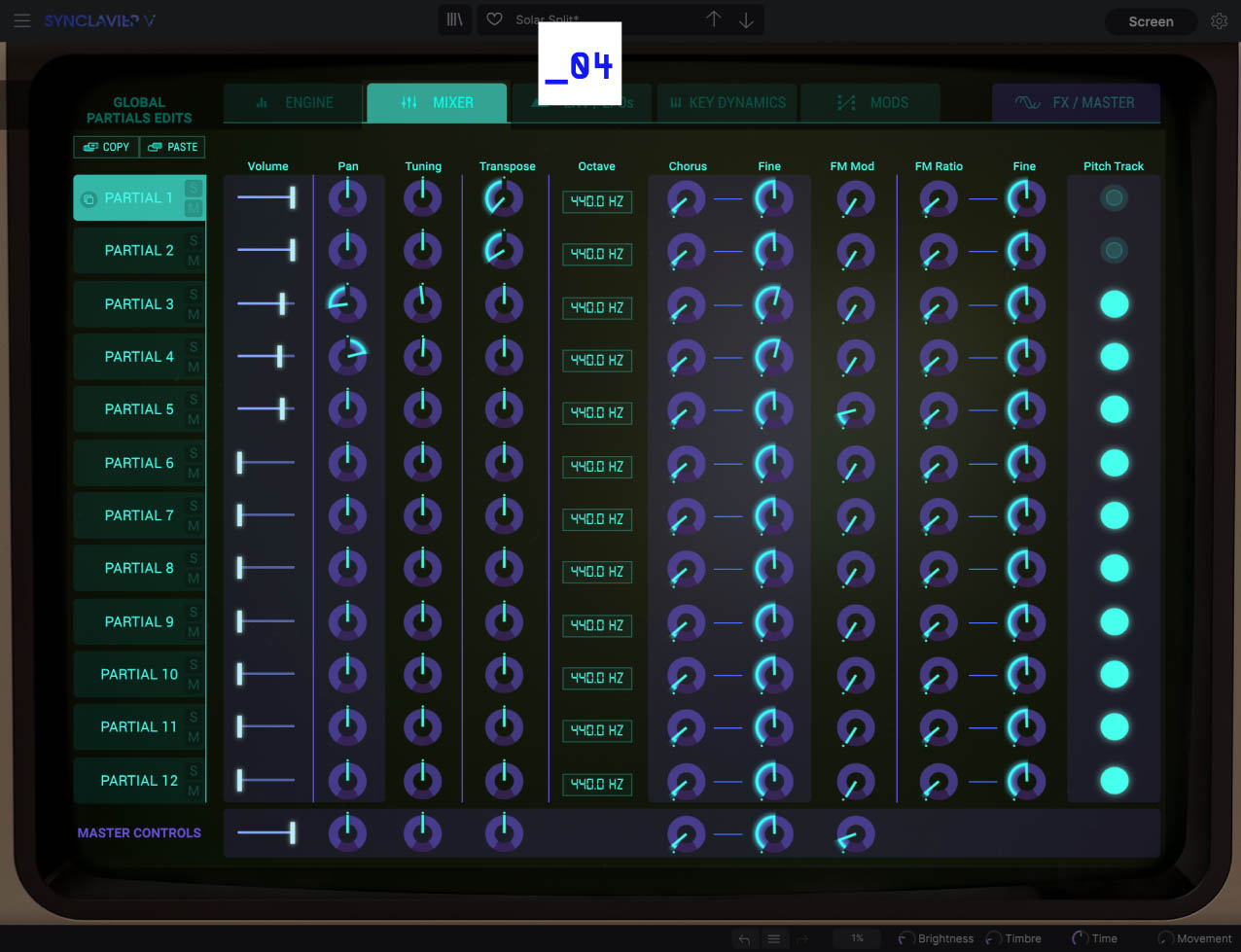
Split, layer, and crossfade all 12 Partials across the keyboard, and make them respond to velocity and the modulation wheel.
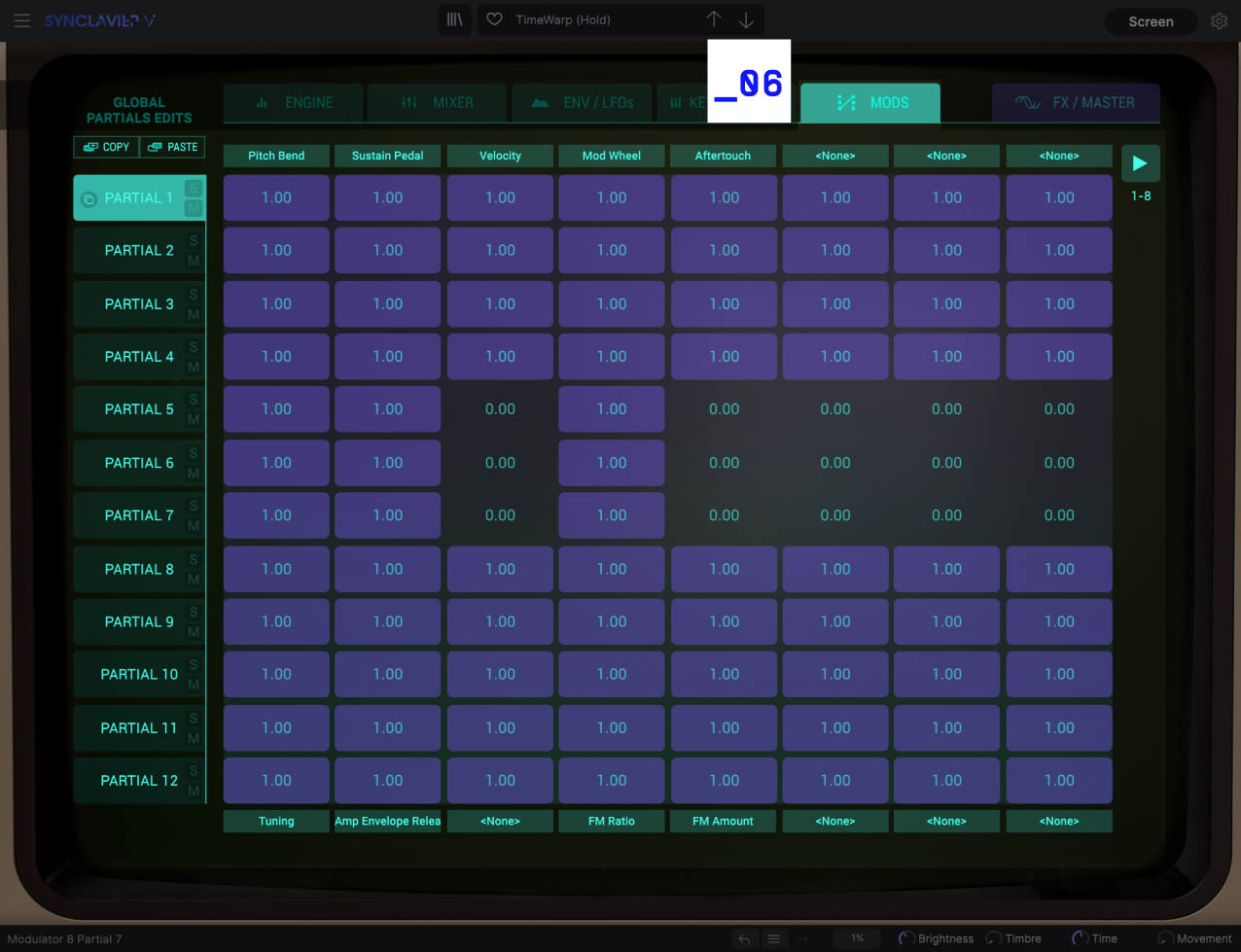
With a 16 x 16 mod matrix for each Partial, you will never run out of expressive possibilities.
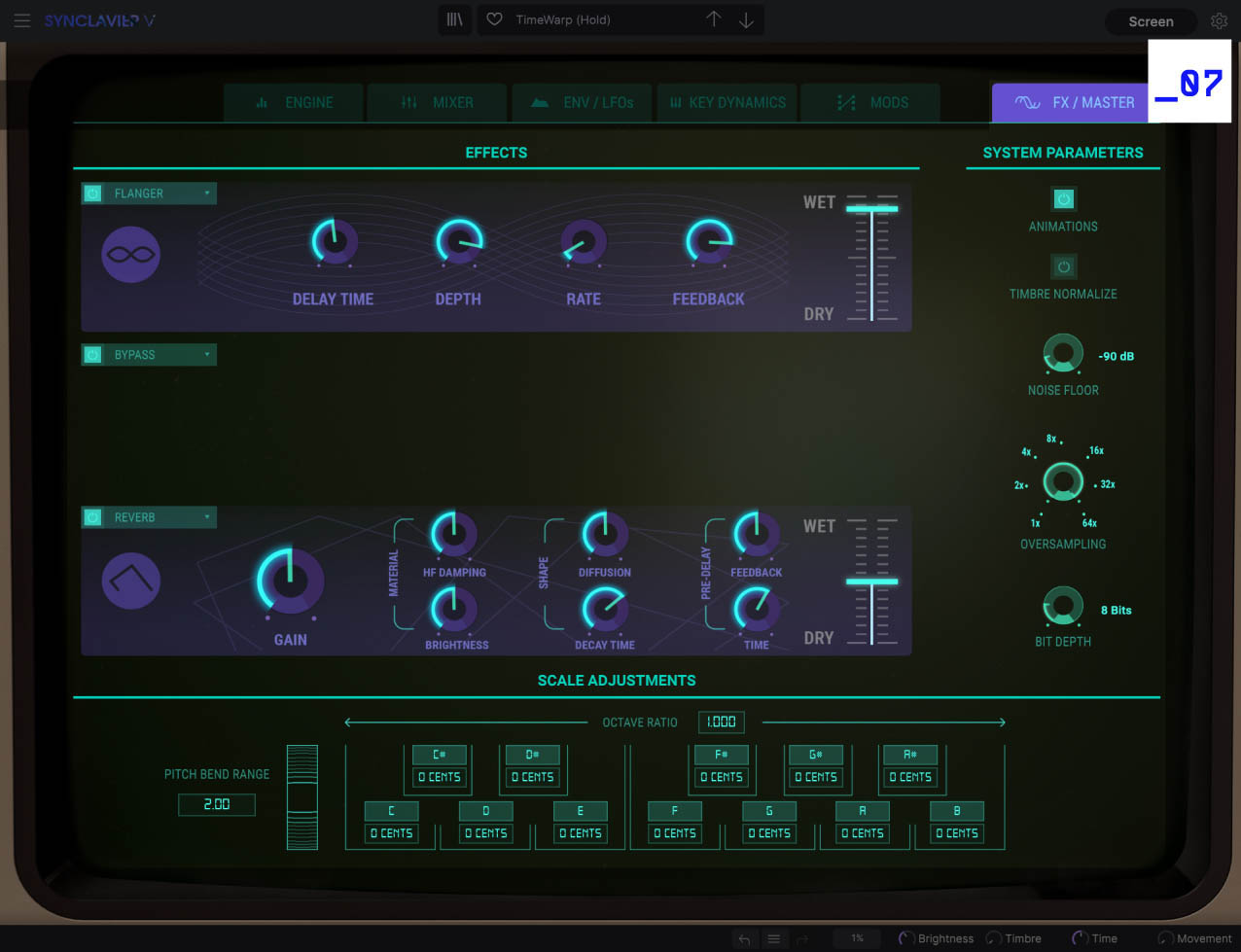
Three effect slots, microtunings, and control over exactly how vintage-digital Synclavier V sounds - it all adds up to a music-making system like no other.
Hear it
in action
The Synclavier was designed to cover any sonic territory and be the last synthesizer its users would ever need.
These audio demos demonstrate the power of Synclavier V in that same spirit, using it for nearly all of their sounds.
Crystal Bells
This demo was made exclusively with the Synclavier V.
Many Mallets
This demo was made exclusively with the Synclavier V.
Pet Wad
This demo was made exclusively with the Synclavier V.
Synclav Techno
Solace
This demo was made exclusively with the Synclavier V.
Jamaican
All sounds come from the Synclavier V!
Revenge
So Digital
This demo was made exclusively with the Synclavier V.
North
This demo was made exclusively with the Synclavier V.
Celestial
Complex ambient track made exclusively with Synclavier V2, using presets that make the most out of the newer features.
New Land
All sounds were created with the Synclavier V2 except the snare drums, Hi Hat and cymbals sounds
Paltan
Electro and melodic track. The presets used in this track are : Butter, Morphing Chorus, Yet So Efficient, Squary Mellow and Initialize System. Additional drums from the Ableton core library.
Artistscorner
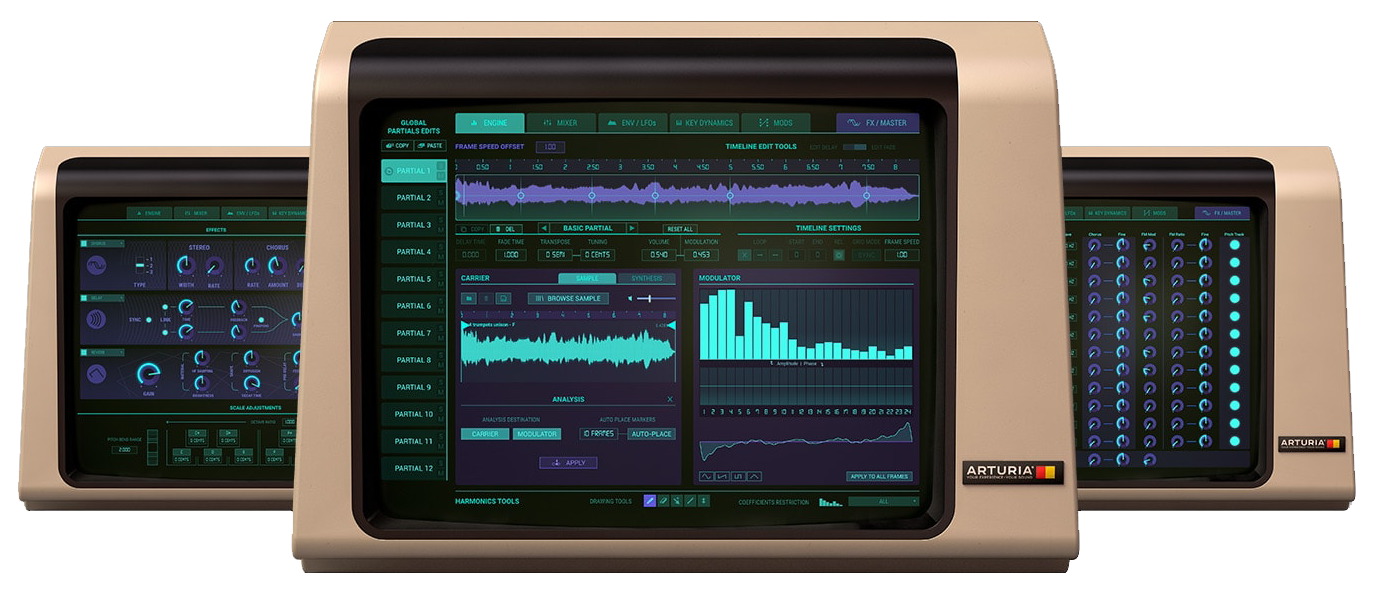
Included in
V collection
Legendary Keyboards Reinvented
This instrument is also part of the V Collection -your complete dream line-up of the legendary synths, organs, pianos and more that made keyboard history. They’re modeled with the most advanced technologies for authentic realism, and enhanced with new creative options. Whether you use it as DAW plugins in the studio or standalone at gigs, V Collection puts the greatest keys of all time at your fingertips for instant inspiration.
Learn More
The features
you need

Integrated in-app tutorials guide you through every aspect of the instrument, from individual parameters to tips from our sound designers, so you can focus on the creative stuff. It shouldn't be this easy, but it is!

Arturia Software Center lets you download, organize, and update all of your Arturia software titles in one place, as well as manage all of your licenses across multiple devices. Keep it simple.

Our virtual instruments and plugins are designed to fit right into your setup without hassle. Whatever your style, you can explore sound while enjoying full compatibility with major DAWS, on both Windows and MacOS.

Instantly find the sound that’s in your head with intelligent & streamlined preset browsing. Search with keywords, explore by instrument type, musical style, and more - you can even save your favorites to quickly recall later.

Whether you want the full visual immersion of our classic instrument emulations, or to save precious screen real estate, the interfaces for all of your Arturia virtual instruments can be resized to a scale that suits you.

Instruments come seamlessly mapped for the Arturia KeyLab range - but they’ll place nice with other MIDI controllers too. Instant sound tweaking macros, easy DAW integration, and standalone operation.
Gallery
Main Features
Software synthesizer playable through a MIDI keyboard
450 presets sounds
Original programmer + original code = the original Synclavier synthesis engine
Powerful FM (frequency modulation) synthesis
Full additive synthesis:
- Time Slice engine for dynamic additive synthesis
- Additive waves for both carrier and modulator waveforms
Expanded number of partials to 12 (the original had 4)
Variable bit depths (original was only 8-bit)
High-quality output effects
Algorithmic reverb
50 presets from the original Synclavier library
VST, VST3, AU, AAX, and standalone operation
Support for Native Instruments NKS format
Platform specifications
Windows
- Win 10+ (64bit)
- 4 GB RAM
- 4 cores CPU, 3.4 GHz (4.0 GHz Turbo-boost)
- 3GB free hard disk space
- OpenGL 2.0 compatible GPU
- ARM processors not supported on Windows
Required configuration
- Works in Standalone, VST, AAX, Audio Unit, NKS (64-bit DAWs only).





Apple
- Mac OS 11+
- 4 GB RAM
- 4 cores CPU, 3.4 GHz (4.0 GHz Turbo-boost) or M1 CPU
- 3GB free hard disk space
- OpenGL 2.0 compatible GPU
Work with ASC
- An elegant and simple solution to help you install, activate, and update your Arturia software instruments.
All manufacturer and product names mentioned on this page are trademarks of their respective owners, which are in no way associated or affiliated with Arturia. The trademarks of other manufacturers are used solely to identify the products of those manufacturers whose features and sound were studied during the development. All names of equipment, inventors, and manufacturers have been included for illustrative and educational purposes only, and do not suggest any affiliation or endorsement by any equipment inventor or manufacturer.







